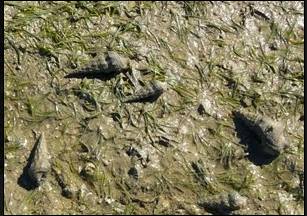Ecology
Pyrazus ebeninus organisms are typically found on estuarine mudflats or swamp mangroves near the high tide mark (Edwards 2009). The organisms are commonly seen on the top of the substrate or partially buried in sediment to provide some crypsis against predators (Fig. 1). Mangrove pneumatophores are often described as unfavorable conditions for these marine snails with access to limited resources and increased competition conditions (Bishop et al. 2007). The pneumatophore environments provide shade conditions on the sediments with a dense root mat that is difficult for burrowing. Shady conditions often decreases the amount of primary productivity and can decrease the sediment metabolism rates. (Bishop et. al 2007) Due to these limitations, The P. ebeninus organisms are typically found dispersed between the rocky intertidal habitats and mudflat mangrove forests. The samples collected in this study were found partially buried approximately 6 m from mangrove pneumatophores approaching the rocky intertidal zone (Fig. 2)
 
Figure 1: Pyrazus ebeninus specimens in their natural environment of a mudflat that provides camouflage against possible predators. (Photo from QLD Museum, 2013)
 
Figure 2: Intertidal mudflat at the high tide mark on North Stradbroke Island where the specimens for this study were collected. |